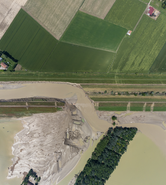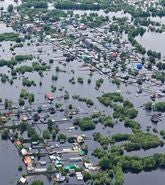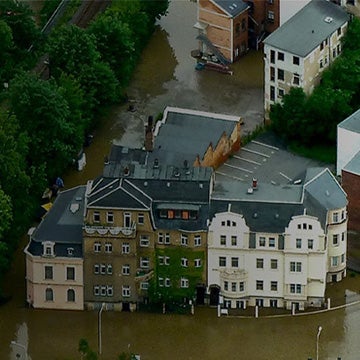Heavy and prolonged precipitation in late May and early June recently triggered severe flooding in central Europe. The precipitation was linked to a low-pressure system with a trajectory from the Mediterranean across central Europe, also known as Van Bebber (Vb-type) cyclones.
This cyclone type is well-known to be responsible for some of the most devastating flood events in central and eastern Europe, such as events in 2002, 2013, 2016, and now 2024.
Moody’s RMS Event Response has estimated the insured losses in southern Germany (mainly Baden-Württemberg and Bavaria) from the central Europe floods to likely be in the range between €2.0 to €3.0 billion (US$2.1 to US$3.2 billion), as of early June 2024.
Although a clearer picture of the loss will emerge with time, it is already clear that the expected insured loss from that event will subsume into a series of multi-billion Euro losses from similar events in the more recent past.
The current event loss will only be surpassed by the ‘Bernd’ Flood in western and central Europe during 2021, dwarfing all other European flood events in the past decades, with a billion euro loss value in the low double digits.
What these events share in common is that a large portion of the losses remain uninsured, as homeowner building insurance in Germany typically covers physical damage from wind storms or hail, but not for flood, as summarized in a recent article from Deutsche Welle.
Insurance penetration has been increasing steadily from about 19 percent before the 2002 floods, to 52 percent in 2023, according to the latest data from the GDV. Baden-Württemberg is an exception with compulsory flood coverage until 1994, after which take-up rates have remained high.
With a string of recent flood events, the flood insurance debate in the country has seen attempts to make flood insurance compulsory across Germany, as the government is assumed to pick up the losses.
After another billion-euro insured loss event, homeowners and businesses are concerned about the risk, the government does not want to be responsible for filling a growing coverage gap, and insurers want to ensure they can price the risk correctly. How can all the stakeholders in the insurance value chain respond?
Building Confidence for Flood Insurers
There are issues across the various parts of the insurance value chain with Europe flood risk. Absorbing billions of euros in losses eating into an insurer’s earnings, reinsurance layers being triggered, or surprising insurance-linked securities (ILS) investors with unanticipated losses through these flood events, is never desirable, and can alert wider stakeholders to question risk management strategy.
Understanding the risk is proving pivotal. To provide confidence in managing this complex risk, comprehensive modeling that captures flood risk holistically is required, as relying on historical data alone is proving inadequate.
Specifically, these regular European flood events highlight how important it is to appropriately capture key elements such as antecedent conditions, Vb-type events, cross-country correlations, flood defenses, and combined fluvial and pluvial flooding.
The latest generation of high-definition (HD) catastrophe risk models offer highly detailed, granular analytics for assessing flood risks.
Models such as Moody’s RMS Europe Inland Flood HD Models are built from a wide spectrum of data, combined with innovative modeling techniques and technology to assess the frequency, severity, and financial impact of flood events across 14 European countries, for large pan-European books of business, right down to individual property coverages.
Our Moody’s RMS Event Response services leverage the models to react quickly to floods as they occur and assess the immediate impact on insured assets. Such wide analytical capabilities are crucial for accurately understanding and managing flood risks and the correlation of risk across the continent.
How can primary insurers, reinsurers, and insurance-linked securities (ILS) providers move forward with their risk understanding, and become more resilient against similar or worse future flood events?
Enhancing Financial Resilience Across The Market
Primary Insurers
For primary insurers, HD flood modeling helps to understand potential flood risk at a granular level – a single property or neighborhood, through to a portfolio, country, or even a continent level. Based on a continuous simulation of all relevant physical processes over 50,000 years, helps build confidence in capturing the full spectrum of the risk at the property level, all the way up to the portfolio level.
Insurers can examine their risk profile across the entire exceedance probability (EP) curve, to fine-tune their approach, and decide the risks they are comfortable with retaining, and the risks where it makes sense to secure reinsurance or other coverage such as using insurance-linked securities (ILS).
To use the HD models to their full potential, insurers also benefit when capturing more granular data for the risks they cover – the more comprehensive and detailed the data is, the greater the understanding they can get from it.
Flood protection measures along major rivers make a big difference to flood losses, and the HD flood models include the latest flood defense data, or where additional data is available, it can assume a bespoke level of flood defense for assets of interest.
This can even be coupled with our climate change-conditioned models in a forward-looking manner accounting for the impact of climate change, such as our work with Flood Re in the U.K.
Moreover, increased resilience of properties through the implementation of property flood resilience measures, as incentivized by programs such as Flood Re’s ‘Build Back Better’ can explicitly be taken into account.
Reinsurers
Flood is a complex, granular risk, and does not lend itself to data aggregation, more aggregation means that risk hot spots and low-risk opportunities get mixed in together.
Using HD modeling, reinsurers can achieve the same granular view as primary insurers, for a clear picture of their potential exposure to flood events, allowing for the design of reinsurance contracts that appropriately cover these risks.
By understanding flood risk in fine detail, reinsurers can take control, such as diversifying their portfolios more effectively and spreading risk across different regions, countries, or Europe, to reduce the impact of any single event on their earnings.
ILS Funds
Insurance-linked securities (ILS) funds are under the spotlight from potential investors to explain the risks they are taking on within a risk bond, whether it is solely focused on Europe flood risk, or if flood risk is packaged within a wider portfolio of risks.
To model the impact of time-based policy conditions such as hours clauses, as the HD models are based on a temporal simulation, users can use them to make informed adjustments to their policy conditions.
Without truly knowing what lies within a portfolio, assumptions must be made and an uncertainty premium can lead to significant market inefficiency and missed opportunity.
At a time when ILS capital is serving as an increasingly important option for the coverage of earnings perils, the discipline and data analysis needed to price investments appropriately, manage earnings risk, and understand risk correlation of risk within their portfolio, will help increase profitability and capital efficiency.
Conclusion
The multi-billion-euro losses experienced in Germany will again raise flood risk up the insurance agenda and across the value chain. Using advanced HD risk models, firms can confidently participate, write more business, protect more homes and commercial clients, minimize uncertainty, and increase capital efficiency.
Find out more about HD Flood Models here.








